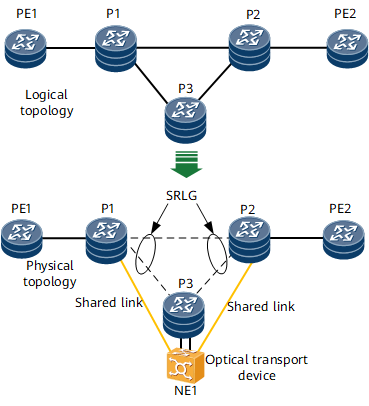SRLG
The shared risk link group (SRLG) functions as a constraint that is used to calculate a backup path in the scenario where CR-LSP hot standby or TE FRR is used. This constraint helps prevent backup and primary paths from overlapping over links with the same risk level, improving MPLS TE tunnel reliability as a consequence.
Background
The primary tunnel is established over the path PE1 → P1 → P2 → PE2 on the network shown in Figure 1. The link between P1 and P2 is protected by a TE FRR bypass tunnel established over the path P1 → P3 → P2.
In the lower part of Figure 1, core nodes P1, P2, and P3 are connected using a transport network device. They share some transport network links marked in yellow. If a fault occurs on a shared link, both the primary and FRR bypass tunnels are affected, causing an FRR protection failure. An SRLG can be configured to prevent the FRR bypass tunnel from sharing a link with the primary tunnel, ensuring that FRR properly protects the primary tunnel.
Related Concepts
An SRLG is a set of links at the same risk of faults. If a link in an SRLG fails, other links also fail. If a link in this group is used by a hot-standby CR-LSP or FRR bypass tunnel, the hot-standby CR-LSP or FRR bypass tunnel cannot provide protection.
Implementation
An SRLG link attribute is a number and links with the same SRLG number are in a single SRLG.
Interior Gateway Protocol (IGP) TE advertises SRLG information to all nodes in a single MPLS TE domain. The constrained shortest path first (CSPF) algorithm uses the SRLG attribute together with other constraints, such as bandwidth, to calculate a path.
The MPLS TE SRLG works in either of the following modes:
Strict mode: The SRLG attribute is a necessary constraint used by CSPF to calculate a path for a hot-standby CR-LSP or an FRR bypass tunnel.
Preferred mode: The SRLG attribute is an optional constraint used by CSPF to calculate a path for a hot-standby CR-LSP or FRR bypass tunnel. For example, if CSPF fails to calculate a path for a hot-standby CR-LSP based on the SRLG attribute, CSPF recalculates the path, regardless of the SRLG attribute.
Usage Scenario
The SRLG attribute is used in either the TE FRR or CR-LSP hot-standby scenario.
Benefits
The SRLG attribute limits the selection of a path for a hot-standby CR-LSP or an FRR bypass tunnel, which prevents the primary and bypass tunnels from sharing links with the same risk level.
